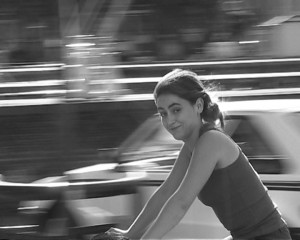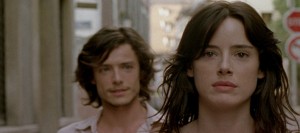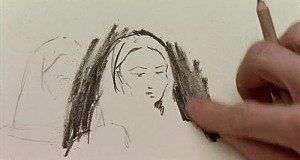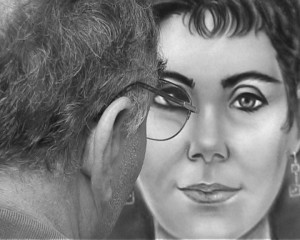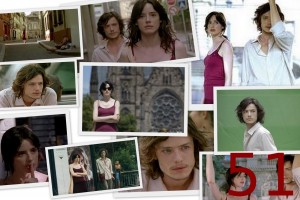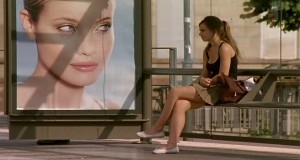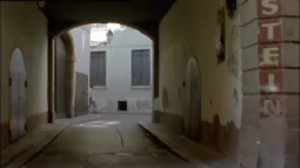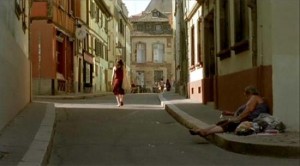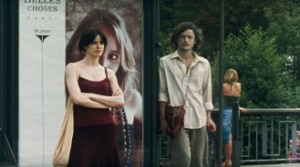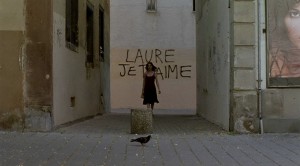Written in April 2011 for the Cinema Guild DVD of In the City of Sylvia and Some Photos in the City of Sylvia. Alas, most of the illustrations used here come from the former of these, the second to have been made. — J.R.
José Luis Guerín’s Some Photos in the City of Sylvia has been described, by myself and others, as a silent, black and white “study” (or filmed “treatment,”or “scenario”) in 2007 that formed the basis for In the City of Sylvia, a color and sound “remake”of the following year. Whether or not this might be technically accurate in terms of causality and financing, it now strikes me as an inadequate way of summarizing the fascinating relation between these two works. I even think it’s an error to view these two films as two versions of the same story — a mistake I made myself when I reviewed them together back in 2008 — because assuming this overlooks too many other things.
Just as there are viewers who prefer Chantal Akerman’s Golden Eighties (1983), her feature-length “preview” to her 1986 musical Window Shopping, and others who prefer Jean-Luc Godard’s 54-minute Scenario du Film “Passion” (1982) to his 88-minute Passion (made the same year), it’s entirely possible to prefer Guerín’s 67-minute “sketch” to his 84-minute feature. In some ways, I do myself — as does another critic, Linda Ehrlich, writing for the online Senses of Cinema, and for what I take to be similar reasons: the fact that Some Photos, with its very musical strategies for editing still photographs to simulate motion and play with our sense of duration, arguably leaves more creative space for our imaginations. But this comparison tends to overlook the degree to which that there’s an ongoing dialogue between these films about their separate playing fields, which don’t even define “play” in the same fashion.
The narrative similarities can’t be overlooked. Both films are set in Strasbourg, where an artist (Guerín himself in Some Photos, a much younger sketch artist in the later film) returns after many years (22 in Some Photos, six in its successor) in search of a young woman named Sylvie whom he met briefly on his previous visit (a nurse in Some Photos, a conservatory student in its follow-up), occasioning in both cases a good deal of girl-watching in which the male voyeur follows one or more of these young women down some of the same streets.
But one can also argue that these films are playing quite different games with different rules.In Some Photos, Guerín ‘s first visit to Strasbourg was prompted by a literary pilgrimage relating to Goethe, and later in that film, he travels to other cities on other romantic literary quests as pretexts for his (and our) girl-watching — heading for Florence to “track” Dante’s Beatrice, and then going elsewhere after Petrarch’s Laura. In the City of Sylvia lacks this back story and these pretexts, for our imaginative wanderings and for Guerín‘s. If the first film’s agendas are more open-ended and abstract, this is partly because they preclude any actual human encounter — and a very awkward and protracted human encounter of cross-purposes and even harassment occupies the middle section of In the City of Sylvia, implicating us as well as the hero. Furthermore, the formal differences between black and white still photographs and silence in Some Photos and color, sound, and motion in In the City of Sylvia are too important to be regarded as incidental. The two films even have separate models in separate media: W.G. Sebald’s illustrated 1990 novel Vertigo, with its own lone literary pilgrimages and black and white illustrations, appears to be an overt reference for Some Photos, and Alfred Hitchcock’s languorous 1958 thriller of the same name seems no less pivotal for its sequel (though it also gets cross-referenced in Some Photos — along with Hitchcock’s Psycho via “the Bates Motel”).
Paradoxically, although the better-known In the City of Sylvia is usually regarded as more “commercial,” it arguably has even less of a plot, and even after its own fictional narrative belatedly emerges in the film’s middle section, it doesn’t seem to remain as the dominant element. One might say, in short, that Some Photos is both more avant-garde and more traditional. especially in its use of language. It promulgates the longstanding European idea of cinema as literature by another means, where language and images comingle and collaborate as equal partners in a joint enterprise. Especially relevant here is the example of Chris Marker — a filmmaker who started out as a literary writer, publishing both a book-length essay and a novel in 1949, and who has continued as a photographer and filmmaker chronicling his own travels, albeit choosing to narrate those travels in quasi-fictional terms, with displaced fictional narrators, and sometimes choosing to restrict himself to still photographs. Perhaps Marker’s most famous film — his 1962 short La jetée, which he has called a ciné-roman or a film-novel — is made up almost exclusively of still photographs.
In the City of Sylvia uses language far more incidentally; its French dialogue is sparse and functional when we hear it, and just as often, we don’t hear it at all, even when we see it being spoken. Reflecting Guerín’s background as a film teacher, film theorist, and cinephile rather than his literary taste, this second film seems grounded more in what he has called (in the online Rouge) “a kind of beauty in the Lumière films that captivates me in a very special way…the friction between the desire for control, and chance.” Recalling a dialogue between Henri Langlois and Jean Renoir in a TV documentary by Eric Rohmer about the Lumière films, he evokes a discussion of the Lumière camera operators: “Perhaps they film an avenue in Lyon, and the film, a single reel, a single take, opens with a tramway crossing in foreground from left to right; then, in the depth of field, a carriage, some pedestrians, some kids, cross the road. And just before the film ends, another train comes in the opposite direction, creating a beautiful sense of symmetry. And you wonder: how is so much beauty possible? That modulation of the internal rhythms of the take. It is without a doubt the result of chance. Reality does not allow itself to be captured just like that, by anyone. Lumière’s operators, when they arrived at the locations for the film, spent a lot of time studying the situation, the movements, the light in different hours of the day….As a result of that study of location and movement they could choose the angle, the distance, and the moment to start and end filming. What results is never just pure chance, but there is a way to play with chance and make it work for you. Like making a pact with chance.”
What kinds of pacts with chance is Guerín making in the protracted pursuit that forms the middle section of In the City of Sylvia? The elements of control are of course less obvious in most cases than those of chance. Viewers who haven’t seen Some Photos are unlikely to notice, for instance, Plutarch’s obsession with Laura duplicated here in Strasbourg’s street graffiti, where “LAURE JE T’AIME” crops up repeatedly and with increasing size and prominence on the various trajectories of the hero and his prey. A recurring literary reference, one might say, cropping up by design in the midst of an extended Lumière sequence. And elsewhere, in contrast to the very musical editing of Some Photos, we find the “modulation of the internal rhythms of the take,” where chance itself is taking over the role formerly played by Goethe, Dante, and Plutarch.

